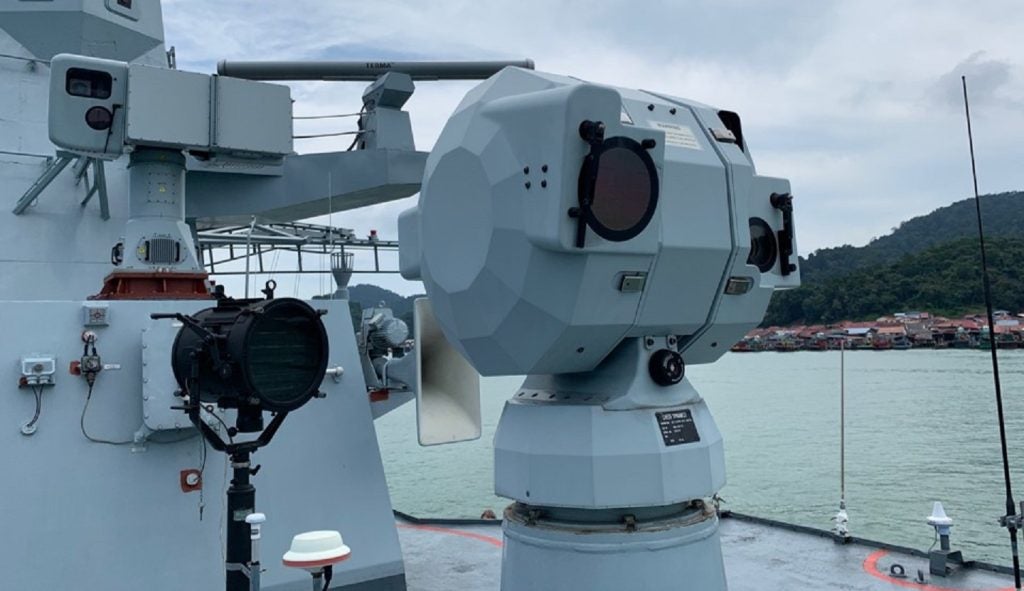In December 2001, Germany placed an order for five K130 corvettes based on the MEKO A design from the Arge K130 consortium. The Arge K130 consortium consists of ThyssenKrupp Marine Systems Blohm +Voss in Hamburg (lead yard) and Nordseewerke in Emden, with Friedrich Lurssen Werft based in Bremen.
The corvettes replace the German Navy’s Tiger Class and Albatross Class missile fast patrol boats which no longer meet operational requirements. The K130 corvettes will be based at Warnemunde.
K130 Braunschweig Class corvette development
Keel-laying of the first of five new K130 corvettes for the German Navy began in December 2003. The first and the fourth corvette were built by Blohm + Voss, the second and fifth by Lürssen and the third by Nordseewerke.
The first of class ship, the FGS Braunshweig (F260), built by Blohm+Voss, was launched in April 2006 and commissioned in April 2008 in the Baltic port of Warnemünde in Northeast Germany. The Braunshweig and the other four ships are to be retrofitted with bow thrusters in order to improve manoeuvrability in port.
The remaining four K130 ships are: FGS Magdeburg (F261) built by Lurssen, launched in September 2006, commissioned in September 2008; FGS Erfurt (F262) built by Thyssen Nordseewerke, launched in March 2007, yet to be commissioned; FGS Oldenburg (F263) built by Blohm + Voss, launched in July 2007, yet to be commissioned; FGS Ludwigshafen (F264) built by Lurssen, launched in September 2007, yet to be commissioned. The gearing problems on FGS Braunshweig and FGS Magdeburg have delayed the commissioning of the remaining vessels.
K130 corvette design and features
The K130 corvettes are designed with stealth features, low draft, and highly automated weapons and defence systems to support littoral warfare and particularly for operations of a multi-national crisis reaction force.
The corvettes have a continuous maximum speed of over 26kt and a cruising range of more than 2,500nm. The displacement is about 1,580t, overall length 88m and breadth 13.2m. The K130 corvettes have an endurance of seven days or, with tender support, 21 days.
A high level of automation and integration, including the automated and integrated bridge, allows the corvettes to be operated by a crew of 50. Some important technologies featured in the type 124 frigates have been incorporated into the K130, including network technology with distributed computer software for weapon, command and control systems.
Command and control
The K130 is equipped with a Thales Netherlands SEWACO sensor, weapon control and command system, together with link 11 and link 16 tactical communications.
Thales Nederland Mirador provides electro-optic surveillance and fire control.
Mirador’s sensors include colour TV camera, infrared camera and an eye-safe laser rangefinder. The identification friend or foe (IFF) is a MSSR 2000 I-type system from Cassidian.
K130’s integrated communications suite includes a UHF satellite-communications (SATCOM) and UHF / VHF / HF communications supplied by EADS.
K130 missiles
The German BWB Federal Office for Defence Technology and Procurement and the German Navy selected the RBS 15 mk3 surface-to-surface missile for the K130 corvettes. The RBS 15 mk3, developed by Saab Bofors Dynamics and Diehl BGT Defence, is a fire-and-forget day and night anti-ship missile with land-attack capability.
The K130 class carries four RBS15 missiles. The missile uses active Ku-band radar homing and has a range of more than 200km. The missile has a high subsonic speed, Mach 0.9, and is armed with a 200kg warhead.
The K130 class corvettes are armed with two Raytheon / RAMSYS Rolling Airframe Missile (RAM) 21-cell mk49 surface-to-air missile launchers. The RAM guided-missile weapon system is a naval self-defence system for engagement of hostile aircraft and incoming missiles. The RAM missile has a dual-mode radar / infrared seeker and a range of 9.5km.
K130 guns
The ship’s main gun is the Oto Melara 62-calibre 76mm Super Rapid naval gun, which has a rate of fire of 120 rounds a minute. The corvette also carries two 27mm Mauser guns.
Countermeasures
The corvettes have two Rheinmetall Defence decoy-based Multi Ammunition Softkill System (MASS) for protection from sensor-guided missile attacks. MASS uses programmable omni-spectral ammunition (OMNI TRAP) for protection against ultraviolet, electro-optical, infrared and radar-guided weapons.
The corvette’s Electronic Support Measures (ESM) system is the EADS SPS-N 5000 radar ESM, operating over frequencies 2GHz to 18GHz. The system intercepts, locates, analyses, classifies and identifies threats and has multiple target tracking capability. The countermeasures suite also includes the EADS SPN / KJS 5000 jammer.
Sensors
EADS Defense Electronics supplied the TRS-3D air and surface search radar which operates at C-band.
The TRS-3D is a 3D multi-mode maritime radar capable of automatic detection and tracking of all types of air and surface threats, including the early detection of low flying or fast moving threats such as missiles, fast boats, unmanned air vehicles and drones.
The corvette is fitted with two Raytheon Marine Pathfinder ST mk2 navigation radars operating at E, F and I bands.
Aircraft
The corvette accommodates one medium-sized helicopter. The K130 corvettes could be equipped with two vertical take-off and landing unmanned air vehicles (VTOL UAVs) for air reconnaissance and over-the-horizon targeting (OTHT), but a decision was taken in 2005 not to install UAV systems on the corvettes.
However, in August and September 2008, a series of trials with the Schiebel Camcopter S-100 UAV was conducted onboard FGS Braunschweig and FGS Magdeburg. The German Navy ordered the first batch of six UAVs for Braunschweig-class corvettes.
Diesel propulsion
The K130 is fitted with two MTU 20V 1163 TB 93 diesel engines producing 14.8MW, driving two controllable-pitch propellers.
CAE supplies the vessel’s integrated machinery control system (IMCS).
The Global Naval Surface Combatants and Warfare Systems Market 2011-2021
This project forms part of our recent analysis and forecasts of the global naval surface combatants and warfare systems market available from our business information platform Strategic Defence Intelligence. For more information click here or contact us: EMEA: +44 20 7936 6783; Americas: +1 415 439 4914; Asia Pacific: +61 2 9947 9709 or via email.













